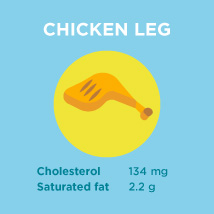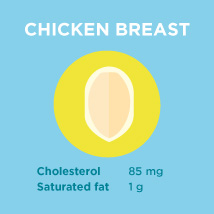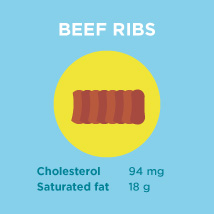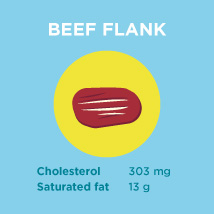Beef Harder to Digest Than Chicken
Chicken and beefiness are both staples of many nutrition, and they can be prepared and seasoned in thousands of different ways.
Unfortunately, these common animal proteins are also sources of the blazon of fat that tin can elevate your risk for loftier cholesterol, heart disease, and cardiovascular problems.
LDL cholesterol contributes to plaque that can clog and narrow your arteries, which tin can break off as clots. This narrowing and these clots can atomic number 82 to a center attack or stroke.
Since your body produces all of the LDL cholesterol it needs, eating foods that are high in saturated fats, like fatty meats, can increment the amount of LDL cholesterol that your body makes.
But that in no way ways fried chicken with the peel on is a better choice than a grilled sirloin steak — at least if you're talking about heart health.
In recent years, the focus has shifted away from how much cholesterol a food contains and shifted to focusing on how much saturated fat that food has.
The more unhealthy saturated fats you consume, the more than LDL cholesterol your body makes, and this is considered more than of import to cholesterol management than the bodily cholesterol content of foods.
In 2015, the
Though they practice keep to say that you should swallow as little cholesterol as possible since foods loftier in cholesterol are normally besides high in saturated fats.
While people presume that chicken is lower in saturated fat than beef, information technology doesn't mean it's necessarily healthier.
Chicken and cows store fat differently, and in different parts of their bodies. For instance, chickens shop fat primarily under the skin, and chicken thighs are higher in fat and cholesterol than breast meat.
Come across the cholesterol and saturated fat content of every three.5-ounce cut of these meats:






The
Fish like salmon, trout, and herring tend to be college in omega-3 fatty acids. Grass-fed beef is too higher in omega-3 fatty acids, equally compared to manufactory-farmed beef.
The AHA further recommends limiting fifty-fifty lean cuts of beef or skinless chicken to less than 6 ounces a day, which is about the size of two decks of cards.
Fifty-fifty if you cull lean meats, you can easily add together extra saturated fats to them during the cooking procedure.
Deep-frying in lard? Wrapping information technology in salary? That'll disengage what you're trying to achieve.
Here are some ways that center wellness experts say yous can reduce your cholesterol levels through diet:
Selection
Choose lean cuts of beef, like round, chuck, sirloin, or loin.
When you're eating chicken, swallow the white meat only.
Avoid processed meats like salami, hot dogs, or sausages. The about heart-healthy cuts of meat are commonly labeled "choice" or "select." Avoid labels like "prime."
Cooking
Before you even start to melt information technology, trim the fat off of your beef. Continue to skim off the fatty if you're making a stew or soup.
Avert frying your food. Opt to grill it or broil information technology instead, and continue the meat moist while cooking it, with wine, fruit juice, or a low-calorie marinade.
The kind of oil y'all use as well makes an bear upon on your cholesterol intake. Butter, lard, and shortening should go out the window considering they're high in cholesterol and saturated fat.
Oils based from vegetables, including canola, safflower, sunflower, soybean, or olive oil are significantly more heart-healthy.
Likewise make sure to include enough of vegetables, as fiber can help reduce cholesterol absorption afterwards a meal.
Finally, don't replace your fat intake with carbohydrates every bit this won't reduce your chances of coronary avenue disease.
Source: https://www.healthline.com/health/high-cholesterol/chicken-vs-beef

0 Response to "Beef Harder to Digest Than Chicken"
Post a Comment